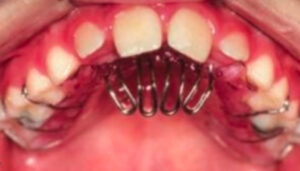What is the lingual grid
The lingual grid is an orthodontic appliance designed to prevent habits such as tongue thrusting (when the tongue is placed between the front teeth while at rest, when speaking or swallowing) and atypical swallowing (when swallowing, the tongue is placed between the teeth), which can interfere with the correct development of occlusion and dental alignment. These oral habits, if not corrected in time, can lead to malocclusions, dental displacement and even affect the growth of the jaws, complicating future orthodontic treatment.
It is a metal or acrylic structure that is fixed to the inner side of the upper or lower teeth, creating a physical barrier that prevents the tongue from pushing on the anterior teeth. It can be permanently cemented or removable. The use of the lingual grid should always be supervised by an orthodontist, who will assess the duration of the treatment and make the necessary adjustments according to the patient’s evolution.
How is the lingual grid used?
- Correction of atypical swallowing: Prevents the tongue from getting between the teeth when swallowing.
- Treatment of harmful oral habits: Helps eliminate tongue thrusting and can be used in cases of digital sucking or prolonged pacifier use.
- Prevention of malocclusions: By avoiding lingual pressure on the incisors, it helps to correct open bites or dental protrusion.
Types of lingual grid
-
Fixed lingual grid:
Cemented to the molars (“molars”), it provides constant correction without the need for patient cooperation.
-
Removable lingual grid:
Similar to an acrylic plate with metal grid; useful in young children when a less invasive solution is sought.
Does it affect speech and nutrition?
- It may cause initial discomfort and affect speech temporarily.
- Orthodontist supervision is essential to evaluate its effectiveness and fit.
- It can be combined with myofunctional therapy to re-educate tongue function.
Differences between lingual trap and lingual grid
The lingual grid and the lingual trap are orthodontic appliances designed to correct oral habits such as tongue thrusting and atypical swallowing, but they differ in their design, function and use.
- Tongue Grid: For patients with moderate tongue thrusting, especially in children and adolescents with anterior open bite or atypical swallowing.
- Tongue trap: For more severe cases in which the tongue continues to interfere despite the use of other appliances or myofunctional therapy.
Both devices can be part of a comprehensive orthodontic treatment and, in many cases, are combined with myofunctional therapy to re-educate the lingual musculature and ensure stable results.
Care of the lingual grid
Taking care of a lingual grid is essential to ensure its effectiveness and avoid discomfort or complications during treatment. Here are some recommendations:
-
Rigorous oral hygiene
- Brush teeth after each meal, paying special attention to the area where the grid is located.
- Use a soft bristle brush and, if possible, an interproximal brush to clean between the wires.
- Supplement with alcohol-free mouthwash to reduce the risk of irritation or bacterial build-up.
- Use dental floss or oral irrigator to remove food debris in hard-to-reach areas.
-
Adequate food
- Avoid sticky or hard foods such as chewing gum, candy, nuts and crusty bread, as they may damage it.
- Opt for a soft diet at first until you get used to the appliance.
-
Adaptation and comfort
- Initial discomfort is normal, but will disappear in a few days. Orthodontic wax can be used in case of chafing.
- If there is difficulty speaking, practicing with reading aloud helps with adaptation.
- Avoid pushing the grid with the tongue so as not to interfere with the treatment.
-
Maintenance and servicing
- Attend checkups with the orthodontist to make sure the grid is in place and working properly.
- Do not attempt to manipulate or remove it in case of discomfort; any adjustment should be made by the specialist.



